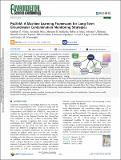| dc.contributor.author | Meray, Aurelien O | |
| dc.contributor.author | Sturla, Savannah | |
| dc.contributor.author | Siddiquee, Masudur R | |
| dc.contributor.author | Serata, Rebecca | |
| dc.contributor.author | Uhlemann, Sebastian | |
| dc.contributor.author | Gonzalez-Raymat, Hansell | |
| dc.contributor.author | Denham, Miles | |
| dc.contributor.author | Upadhyay, Himanshu | |
| dc.contributor.author | Lagos, Leonel E | |
| dc.contributor.author | Eddy-Dilek, Carol | |
| dc.contributor.author | Wainwright, Haruko M | |
| dc.date.accessioned | 2023-01-20T19:56:50Z | |
| dc.date.available | 2023-01-20T19:56:50Z | |
| dc.date.issued | 2022-05-03 | |
| dc.identifier.uri | https://hdl.handle.net/1721.1/147625 | |
| dc.description.abstract | In this study, we have developed a comprehensive machine learning (ML) framework for long-term groundwater contamination monitoring as the Python package PyLEnM (Python for Long-term Environmental Monitoring). PyLEnM aims to establish the seamless data-to-ML pipeline with various utility functions, such as quality assurance and quality control (QA/QC), coincident/colocated data identification, the automated ingestion and processing of publicly available spatial data layers, and novel data summarization/visualization. The key ML innovations include (1) time series/multianalyte clustering to find the well groups that have similar groundwater dynamics and to inform spatial interpolation and well optimization, (2) the automated model selection and parameter tuning, comparing multiple regression models for spatial interpolation, (3) the proxy-based spatial interpolation method by including spatial data layers or in situ measurable variables as predictors for contaminant concentrations and groundwater levels, and (4) the new well optimization algorithm to identify the most effective subset of wells for maintaining the spatial interpolation ability for long-term monitoring. We demonstrate our methodology using the monitoring data at the Savannah River Site F-Area. Through this open-source PyLEnM package, we aim to improve the transparency of data analytics at contaminated sites, empowering concerned citizens as well as improving public relations. | en_US |
| dc.language.iso | en | |
| dc.publisher | American Chemical Society (ACS) | en_US |
| dc.relation.isversionof | 10.1021/acs.est.1c07440 | en_US |
| dc.rights | Creative Commons Attribution-NonCommercial-NoDerivs License | en_US |
| dc.rights.uri | http://creativecommons.org/licenses/by-nc-nd/4.0/ | en_US |
| dc.source | ACS | en_US |
| dc.title | PyLEnM: A Machine Learning Framework for Long-Term Groundwater Contamination Monitoring Strategies | en_US |
| dc.type | Article | en_US |
| dc.identifier.citation | Meray, Aurelien O, Sturla, Savannah, Siddiquee, Masudur R, Serata, Rebecca, Uhlemann, Sebastian et al. 2022. "PyLEnM: A Machine Learning Framework for Long-Term Groundwater Contamination Monitoring Strategies." Environmental Science & Technology, 56 (9). | |
| dc.contributor.department | Massachusetts Institute of Technology. Department of Nuclear Science and Engineering | en_US |
| dc.relation.journal | Environmental Science & Technology | en_US |
| dc.eprint.version | Final published version | en_US |
| dc.type.uri | http://purl.org/eprint/type/JournalArticle | en_US |
| eprint.status | http://purl.org/eprint/status/PeerReviewed | en_US |
| dc.date.updated | 2023-01-20T19:52:56Z | |
| dspace.orderedauthors | Meray, AO; Sturla, S; Siddiquee, MR; Serata, R; Uhlemann, S; Gonzalez-Raymat, H; Denham, M; Upadhyay, H; Lagos, LE; Eddy-Dilek, C; Wainwright, HM | en_US |
| dspace.date.submission | 2023-01-20T19:53:10Z | |
| mit.journal.volume | 56 | en_US |
| mit.journal.issue | 9 | en_US |
| mit.license | PUBLISHER_CC | |
| mit.metadata.status | Authority Work and Publication Information Needed | en_US |
